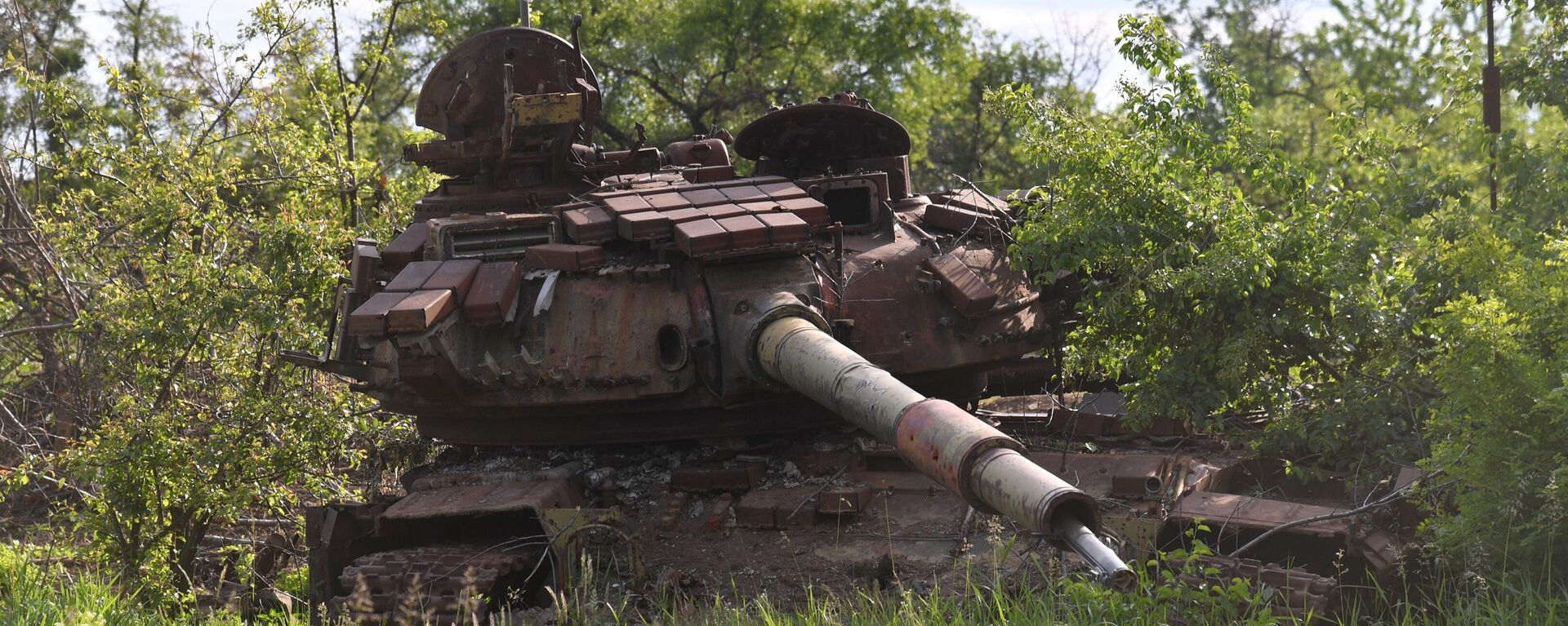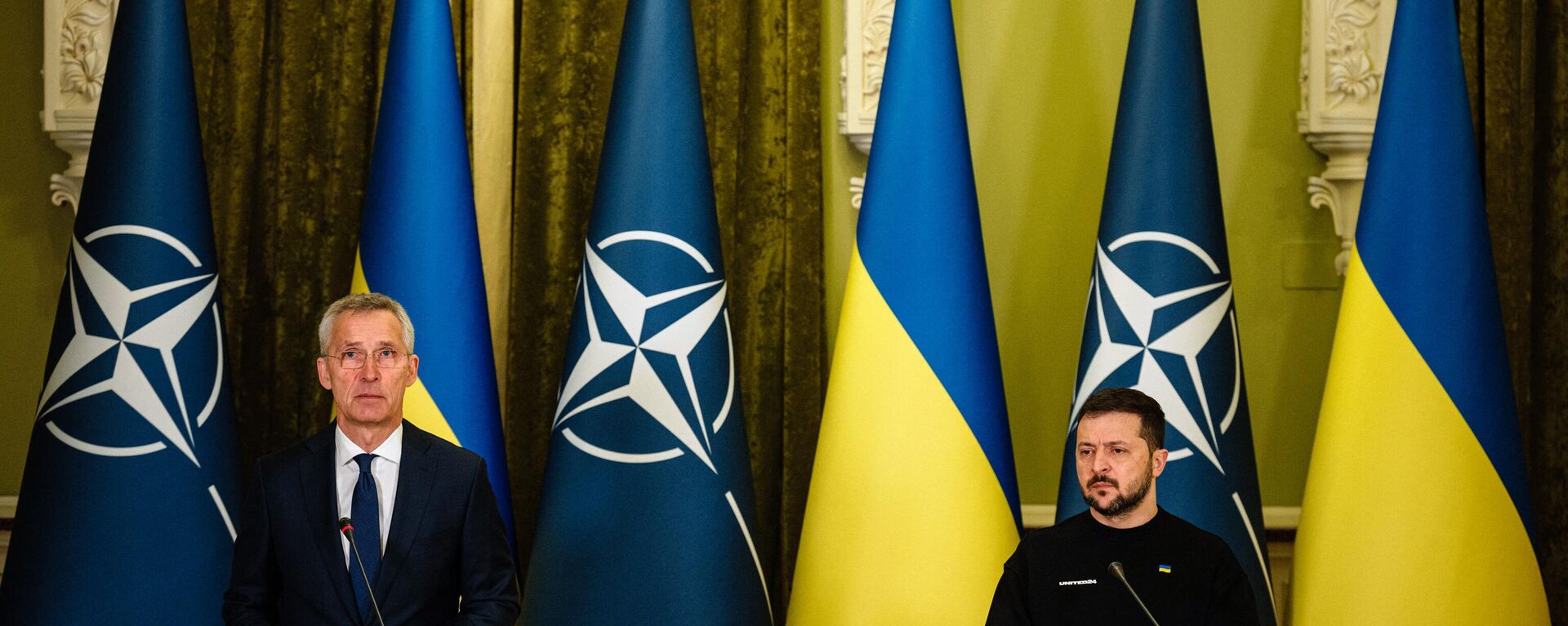https://sputnikglobe.com/20230728/scott-ritter-ukrainian-counteroffensive-keeps-repeating-same-insane-mistakes-1112225788.html
Scott Ritter: Ukrainian Counteroffensive Keeps Repeating Same 'Insane' Mistakes
Scott Ritter: Ukrainian Counteroffensive Keeps Repeating Same 'Insane' Mistakes
Sputnik International
There are contradictory reports emerging from the Zaporozhye battlefield, with Ukrainian forces attempting to make a breakthrough near the village of Robotino.
2023-07-28T16:39+0000
2023-07-28T16:39+0000
2023-07-28T18:42+0000
analysis
ukrainian crisis
us arms for ukraine
valery zaluzhny
volodymyr zelensky
melitopol
nato
ukrainian counteroffensive attempt
ukraine
russia
https://cdn1.img.sputnikglobe.com/img/07e7/04/12/1109628347_0:35:710:434_1920x0_80_0_0_b1e3152eb3d7577d6743b8362a7a7a0d.jpg
While the fog of war prevents a definitive account at this juncture of what is transpiring in and around Rabotino, one thing is for certain—this isn’t Ukraine’s first attempt to breach the Russian defenses there and, if they have indeed failed, this will not be there last.The Battle for Rabotino may very well go down in the history of the Russian-Ukrainian conflict as a modern-day version of the Battle for Prokhorovka, fought on July 12, 1943, between the German and Soviet armies. In Prokhorovka, the Soviet defenses broke the back of the German armor attack. A similar situation appears to be unfolding today around the village of Rabotino, where Russian defenders are engaging Ukrainian attackers mounted on US- and German-made armor.Ukraine and its NATO masters, in unleashing a renewed effort to break through Russian defenses in Zaporozhye, appear to be taking a lesson from the history of Scotland. Legend has it that Robert the Bruce, the first King of Scotland, after watching a spider fail in its attempt to build a web, only to try again, and again, until it was successful, used that experience as motivation for his persistence in his struggle against the English Crown.Robert the Bruce’s observations would later serve as the inspiration for the American educator, Thomas Palmer, who, in a teacher’s manual he authored in 1840, wrote the following: “‘Tis a lesson you should heed, Try, try again. If at first, you don’t succeed, Try, try again.”Persistence bests describes what is unfolding on the battlefields in what Russia now calls “New Russia”—suicidal forays by Ukrainian forces into the prepared defensive positions of their Russian opponents which, to date, have achieved little more than dead bodies and destroyed vehicles.Persistence, as the case of Robert the Bruce shows, can—and often does—prevail in the face of adversity. When the current Ukrainian counteroffensive was first conceived, back in the fall of 2022, Ukraine was coming off a case study in persistence that had, in fact, paid off—a successful counteroffensive that had succeeded in pushing Russian forces out of the Kharkov region, and which recaptured the right bank of Kherson Oblast, including the city of Kherson. This success was facilitated by the provision by NATO of tens of billions of dollars’ worth of military equipment and training, along with operational planning support informed by NATO intelligence, surveillance, and reconnaissance resources.When the fall counteroffensive ran its course, the Ukrainian’s and their NATO masters turned to the task of building a new Ukrainian army to replace the one that had shed its blood in Kharkov and Kherson, a new Ukrainian army which would seek to resume offensive operations in the spring of 2023.None of this was secret. In a revealing interview, the commander of the Ukrainian armed forces, General Valery Zaluzhny, declared that the goal of the spring 2023 operations was to break through Russian defenses in the Zaporozhye zone of operations and advance 84 kilometers to the city of Melitopol, control of which, Zaluzhny stated, “would give us a full fire control of the land corridor [connecting the Crimean peninsula to the Donbass and Russia], because from Melitopol we can already fire at the Crimean Isthmus.”Zaluzhny, expressing confidence derived from recent battlefield success, declared “I know that I can beat this enemy,” before adding a caveat: “But I need resources.” Zaluzhny said that “I can calculate, based on the task at hand, what kind of resource is needed to build combat capability,” before citing numbers: “I need 300 tanks, 600-700 infantry fighting vehicles, 500 Howitzers.” Zaluzhny was quick to note, “I’m not talking about F-16s right now.” But he did say he needed artillery ammunition—lots of it. And he stated that NATO was unable to meet this need.Zaluzhny got the equipment he was looking for. His forces were dispatched to NATO nations for training, while his battleplans were closely coordinated with Ukraine’s NATO partners. Select Ukrainian units were dispatched to Grafenwoehr, Germany, where they were provided with a five-week course taught by US instructors that focused on how to effectively conduct company- and battalion-size combined-arms operations integrating artillery, armor and infantry forces.Zaluzhny’s objective was the city of Melitopol. To get there, the Ukrainian army needed to breach Russian defenses which had been prepared for months. Ukrainian commanders and their NATO partners believed that they key to victory was to pit well-trained, well-equipped, and highly motivated Ukrainian forces up against Russian troops whose training and moral were deemed inferior and who, it subjected to the full weight of the Ukrainian attack, would break and run.In January 2023, Ukrainian forces began probing the Russian defenses, looking for the weakest point that would then be turned into the focal point of their assault. Near the village of Rabotino, in Zaporozhye, they believed they found it—a seam between the 291stMotorized Rifle Regiment (MRR) and the 70th MRR of the 42ndGuard Motorized Rifle Division.NATO picked its two best-trained and best equipped Ukrainian brigades—the 33rd, which operated the US-made M-2 Bradley infantry fighting vehicle, and the 47th, which was equipped with German-made Leopard main battle tanks. Both brigades had been trained by the US in combined arms tactics, which they were tasked with employing with full force along the seam between the 291st MRR and the 70th MRR. The Ukrainian soldiers were led to believe that the Russian troops assigned to these tow units would run away or surrender at the first sign of serious fighting.The Ukrainian attack began on June 8, 2023, striking towards the Russian defenses in and around the village of Rabotino. Within hours it was clear to all involved that the expectations of the Ukrainian and NATO commanders did not match the reality on the ground—the Russian soldiers manning the Rabotino defenses held fast, a by-product of good training, outstanding leadership, sound tactics, and adequate equipment. The Ukrainians, on the other hand, failed dismally, littering the battlefield with burned out Bradley IFV’s and Leopard MBT’s, and the bodies of Ukrainian soldiers. Successive attacks over the course of the proceeding days achieved similar results—the Russian’s held fast, while the Ukrainians died.In the weeks that followed, Ukraine appeared to modify its tactics, foregoing the combined arms training it had received in Germany, and instead using infantry attacks, heavily supported by artillery, designed to pick apart the Russian defenses piece by piece. While these attacks initially enjoyed greater success than the early armor-intensive attacks, ultimately they were beaten back by the Russians, with the Ukrainians suffering huge losses in manpower.The failure of the Ukrainian drive on Melitopol was a huge embarrassment for both Ukrainian President Volodymyr Zelensky and his NATO partners when they gathered in Vilnius, Lithuania, for the NATO Summit convened there from July 11-12. In the finger-pointing and recrimination that ensued, Ukraine lambasted the fact that it had been asked to carry out a difficult military task with insufficient resources, specifically citing the lack of F-16 fighters (despite the fact that General Zaluzhny had specifically excluded the F-16’s from the list of equipment he said he needed to successfully attack Melitopol.)Meanwhile, NATO put the blame for the failed offensive squarely on the shoulders of Ukrainian officers who had failed to employ properly the tactics they had been taught in Grafenwoehr. A leaked German intelligence report highlighted the shift by Ukraine away from massed armor attacks to smaller infantry-driven assaults as representing a total departure from the combined arms operations taught by NATO. What the German report failed to address is the reality that NATO tried to take operational art that requires months, if not years, to master, and squeeze it into training that lasted only a few weeks.Ukraine came out of the Vilnius Summit faced with a classic Catch-22, “a problem for which the only solution is denied by a circumstance inherent in the problem or by a rule.” If Ukraine wanted its NATO partners to increase military assistance, such as the provision of F-16 fighters, it needed to show progress on the battlefield. But in order to show progress on the battlefield, it had to attack without the support of F-16 fighters, which doomed any such attack to failure.Moreover, the Vilnius Summit exposed the reality of a growing Ukraine fatigue amongst the NATO partners, with several beginning to question their ability to provide open-ended support. Ukraine needs to demonstrate a will and ability to prevail against Russia, many western observers believe, or else the west will have no choice but to begin seeking a diplomatic off-ramp from the war. Such a negotiated settlement could compel Ukraine into accepting the loss of territory currently claimed by Russia as part of the conditions, something that is anathema to the Zelensky government.Faced with the Hobbson’s choice, Zelensky has ordered Zaluzhny to double down on the Zaporozhye offensive, employing Ukrainian forces in a manner consistent with the training received at the hands of NATO over the course of the past 7 months.The American comedian, W.C. Fields, had a different take on Palmer’s “try, try again” ditty, declaring “If at first you don’t succeed, try again. Then give the whole thing up. There’s no use being a fool about it!”What Zelensky, Zaluzhny, and the Ukrainian military is undertaking on the ground around the village of Rabotino is, to put it mildly, foolish. The desire to take Melitopol has become a Holy Grail for Zelensky, one that will cost Ukraine dearly, both in terms of the lives squandered on the battlefield, but also by the geopolitical consequences of extending a fight Ukraine cannot win, both in terms of potential additional territorial losses, and the long-term economic and societal impact of loosing vital resources and infrastructure.Albert Eistein, the famous inventor of quantum physics, had an even more erudite take on the topic of persistence: “Insanity is doing the same thing over and over and expecting different results.”Ukraine’s continued offensive operations in Zaporozhye today represent the literal application of Einstein’s insanity definition.
https://sputnikglobe.com/20230726/nato-stands-no-chance-against-russia-1112153812.html
https://sputnikglobe.com/20230723/cia-vet-weird-that-nato-failed-to-foresee-botched-ukraine-counteroffensive-1112095494.html
https://sputnikglobe.com/20230723/wests-hopes-for-breakthrough-in-ukraines-counteroffensive-dashed-1112089912.html
https://sputnikglobe.com/20230714/vilnius-summit-locks-ukraine-in-servile-status-brutal-war-with-no-way-out-1111880520.html
https://sputnikglobe.com/20230721/putin-there-are-no-results-of-ukrainian-counteroffensive-1112030126.html
melitopol
ukraine
russia
Sputnik International
feedback@sputniknews.com
+74956456601
MIA „Rossiya Segodnya“
2023
Scott Ritter
https://cdn1.img.sputnikglobe.com/img/07e6/0c/17/1105733958_0:0:334:334_100x100_80_0_0_b457e4e9c850ef224b0cc79059bb38df.jpg
Scott Ritter
https://cdn1.img.sputnikglobe.com/img/07e6/0c/17/1105733958_0:0:334:334_100x100_80_0_0_b457e4e9c850ef224b0cc79059bb38df.jpg
News
en_EN
Sputnik International
feedback@sputniknews.com
+74956456601
MIA „Rossiya Segodnya“
Sputnik International
feedback@sputniknews.com
+74956456601
MIA „Rossiya Segodnya“
Scott Ritter
https://cdn1.img.sputnikglobe.com/img/07e6/0c/17/1105733958_0:0:334:334_100x100_80_0_0_b457e4e9c850ef224b0cc79059bb38df.jpg
russia special military operation, ukrainian crisis, us arms for ukraine, failed counteroffensive, ukraine war updates, what happens in ukraine, ukraine offensive, ukraine battle
russia special military operation, ukrainian crisis, us arms for ukraine, failed counteroffensive, ukraine war updates, what happens in ukraine, ukraine offensive, ukraine battle
While the fog of war prevents a definitive account at this juncture of what is transpiring in and around Rabotino, one thing is for certain—this isn’t Ukraine’s first attempt to breach the Russian defenses there and, if they have indeed failed, this will not be there last.
The Battle for Rabotino may very well go down in the history of the Russian-Ukrainian conflict as a modern-day version of the
Battle for Prokhorovka, fought on July 12, 1943, between the German and Soviet armies. In Prokhorovka, the Soviet defenses broke the back of the German armor attack. A similar situation appears to be unfolding today around the village of Rabotino, where Russian defenders are engaging Ukrainian attackers mounted on US- and German-made armor.
Ukraine and its NATO masters, in unleashing a renewed effort to break through Russian defenses in Zaporozhye, appear to be taking a lesson from the history of Scotland. Legend has it that Robert the Bruce, the first King of Scotland, after watching a spider fail in its attempt to build a web, only to try again, and again, until it was successful, used that experience as motivation for his persistence in his struggle against the English Crown.
Robert the Bruce’s observations would later serve as the inspiration for the American educator, Thomas Palmer, who, in a teacher’s manual he authored in 1840, wrote the following: “‘Tis a lesson you should heed, Try, try again. If at first, you don’t succeed, Try, try again.”
Persistence bests describes what is unfolding on the battlefields in what Russia now calls “New Russia”—suicidal forays by Ukrainian forces into the prepared defensive positions of their Russian opponents which, to date, have achieved little more than
dead bodies and destroyed vehicles.Persistence, as the case of Robert the Bruce shows, can—and often does—prevail in the face of adversity. When the current Ukrainian counteroffensive was first conceived, back in the fall of 2022, Ukraine was coming off a case study in persistence that had, in fact, paid off—a successful counteroffensive that had succeeded in pushing Russian forces out of the Kharkov region, and which recaptured the right bank of Kherson Oblast, including the city of Kherson. This success was facilitated by the provision by NATO of tens of billions of dollars’ worth of military equipment and training, along with operational planning support informed by NATO intelligence, surveillance, and reconnaissance resources.
When the fall counteroffensive ran its course, the Ukrainian’s and their NATO masters turned to the task of building a new Ukrainian army to replace the one that had shed its blood in Kharkov and Kherson, a new Ukrainian army which would seek to resume offensive operations in the spring of 2023.
None of this was secret. In a revealing interview, the commander of the Ukrainian armed forces, General Valery Zaluzhny, declared that the goal of the spring 2023 operations was to break through Russian defenses in the Zaporozhye zone of operations and advance 84 kilometers to the city of Melitopol, control of which, Zaluzhny stated, “would give us a full fire control of the land corridor [connecting the Crimean peninsula to the Donbass and Russia], because from Melitopol we can already fire at the Crimean Isthmus.”
Zaluzhny, expressing confidence derived from recent battlefield success, declared “I know that I can beat this enemy,” before adding a caveat: “But I need resources.” Zaluzhny said that “I can calculate, based on the task at hand, what kind of resource is needed to build combat capability,” before citing numbers: “I need 300 tanks, 600-700 infantry fighting vehicles, 500 Howitzers.” Zaluzhny was quick to note, “
I’m not talking about F-16s right now.” But he did say he needed artillery ammunition—lots of it. And he stated that NATO was unable to meet this need.
Zaluzhny got the equipment he was looking for. His forces were dispatched to NATO nations for training, while his battleplans were closely coordinated with Ukraine’s NATO partners. Select Ukrainian units were dispatched to Grafenwoehr, Germany, where they were provided with a five-week course taught by US instructors that focused on how to effectively conduct company- and battalion-size combined-arms operations integrating artillery, armor and infantry forces.
Zaluzhny’s objective was the city of Melitopol. To get there, the Ukrainian army needed to breach Russian defenses which had been prepared for months. Ukrainian commanders and their NATO partners believed that they key to victory was to pit well-trained, well-equipped, and highly motivated Ukrainian forces up against Russian troops
whose training and moral were deemed inferior and who, it subjected to the full weight of the Ukrainian attack, would break and run.
In January 2023, Ukrainian forces began probing the Russian defenses, looking for the weakest point that would then be turned into the focal point of their assault. Near the village of Rabotino, in Zaporozhye, they believed they found it—a seam between the 291stMotorized Rifle Regiment (MRR) and the 70th MRR of the 42ndGuard Motorized Rifle Division.
NATO picked its two best-trained and best equipped Ukrainian brigades—the 33rd, which operated the US-made M-2 Bradley infantry fighting vehicle, and the 47th, which was equipped with German-made Leopard main battle tanks. Both brigades had been trained by the US in combined arms tactics, which they were tasked with employing with full force along the seam between the 291st MRR and the 70th MRR. The Ukrainian soldiers were led to believe that the Russian troops assigned to these tow units would run away or surrender at the first sign of serious fighting.
The Ukrainian attack began on June 8, 2023, striking towards the Russian defenses in and around the village of Rabotino. Within hours it was clear to all involved that the expectations of the Ukrainian and NATO commanders did not match the reality on the ground—the Russian soldiers manning the Rabotino defenses held fast, a by-product of good training, outstanding leadership, sound tactics, and adequate equipment.
The Ukrainians, on the other hand, failed dismally, littering the battlefield with burned out Bradley IFV’s and Leopard MBT’s, and the bodies of Ukrainian soldiers. Successive attacks over the course of the proceeding days achieved similar results—the Russian’s held fast, while the Ukrainians died.
In the weeks that followed, Ukraine appeared to modify its tactics, foregoing the combined arms training it had received in Germany, and instead using infantry attacks, heavily supported by artillery, designed to pick apart the Russian defenses piece by piece. While these attacks initially enjoyed greater success than the early armor-intensive attacks, ultimately they were beaten back by the Russians, with the Ukrainians suffering huge losses in manpower.
The failure of the Ukrainian drive on Melitopol was a huge embarrassment for both Ukrainian President Volodymyr Zelensky and his NATO partners when they gathered in Vilnius, Lithuania, for the NATO Summit convened there from July 11-12. In the finger-pointing and recrimination that ensued, Ukraine lambasted the fact that it had been asked to carry out a difficult military task with insufficient resources, specifically citing the lack of F-16 fighters (despite the fact that General Zaluzhny had specifically excluded the F-16’s from the list of equipment he said he needed to successfully attack Melitopol.)
Meanwhile, NATO put the blame for the failed offensive squarely on the shoulders of Ukrainian officers who had failed to employ properly the tactics they had been taught in Grafenwoehr. A leaked German intelligence report highlighted the shift by Ukraine away from massed armor attacks to smaller infantry-driven assaults as representing a total departure from the combined arms operations taught by NATO. What the German report failed to address is the reality that NATO tried to take operational art that requires months, if not years, to master, and squeeze it into training that lasted only a few weeks.
Ukraine came out of the Vilnius Summit faced with a classic Catch-22, “a problem for which the only solution is denied by a circumstance inherent in the problem or by a rule.” If Ukraine wanted its NATO partners to increase military assistance, such as the provision of F-16 fighters, it needed to show progress on the battlefield. But in order to show progress on the battlefield, it had to attack without the support of F-16 fighters, which doomed any such attack to failure.
Moreover, the Vilnius Summit exposed the reality of a
growing Ukraine fatigue amongst the NATO partners, with several beginning to question their ability to provide open-ended support. Ukraine needs to demonstrate a will and ability to prevail against Russia, many western observers believe, or else the west will have no choice but to begin seeking a diplomatic off-ramp from the war. Such a negotiated settlement could compel Ukraine into accepting the loss of territory currently claimed by Russia as part of the conditions, something that is anathema to the Zelensky government.
Faced with the Hobbson’s choice, Zelensky has ordered Zaluzhny to double down on the Zaporozhye offensive, employing Ukrainian forces in a manner consistent with the training received at the hands of NATO over the course of the past 7 months.
The American comedian, W.C. Fields, had a different take on Palmer’s “try, try again” ditty, declaring “If at first you don’t succeed, try again. Then give the whole thing up. There’s no use being a fool about it!”
What Zelensky, Zaluzhny, and the Ukrainian military is undertaking on the ground around the village of Rabotino is, to put it mildly, foolish. The desire to take Melitopol has become a Holy Grail for Zelensky, one that will cost Ukraine dearly, both
in terms of the lives squandered on the battlefield, but also by the geopolitical consequences of extending a fight Ukraine cannot win, both in terms of potential additional territorial losses, and the long-term economic and societal impact of loosing vital resources and infrastructure.
Albert Eistein, the famous inventor of quantum physics, had an even more erudite take on the topic of persistence: “Insanity is doing the same thing over and over and expecting different results.”
Ukraine’s continued offensive operations in Zaporozhye today represent the
literal application of Einstein’s insanity definition.








